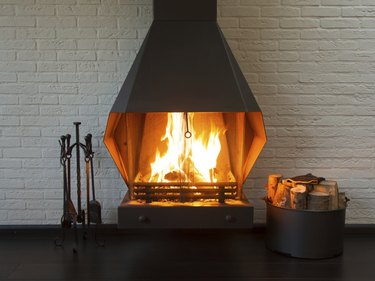
Osage orange tree (Maclura pomifera), known as a hedgeapple, is native in Texas, Arkansas and Oklahoma but is now found throughout the continental United States. A favorite hedgerow tree, it attains a height of approximately 30 feet according to the U.S. Forest Service. Osage was used as firewood by Native Americans and is still used for this purpose as it burns hot and slow while producing a pleasant fragrance. Osage firewood does, however, have some negative traits.
Sparks
Video of the Day
Considered one of the densest woods in the U.S., Osage burns very hot. This creates the potential for sparks and, in a fireplace setting, Osage can send a shower of sparks out onto the hearth or surrounding floor. This poses a serious fire danger and makes the wood better suited for burning in a wood stove. A wood stove can contain the sparks better than a fireplace, which often allows sparks to escape through the large door opening, even with a screen.
Video of the Day
Flue or Roof Fire
Because Osage wood frequently sparks, a flue fire is potentially more likely than when burning other woods. Sparks can also leave the top of the chimney in a gust of wind and cause the roof of the house to catch fire. A fireplace equipped with a metal spark arrester at the top of the flue is recommended for all fireplaces, but particularly when burning woods like Osage.
Excessive Heat and Smoke
Osage wood produces excessive heat, making it more ideal for wood stoves than fireplaces. The high temperatures of Osage may increase the likelihood of bricks cracking in the firebox of some fireplaces. If you do burn Osage in a fireplace, leave the glass doors open so there is less risk of overheating the glass. Never burn this wood in a fireplace that is located less than 3 feet from unprotected drapes or other flammable materials. Osage wood also produces an abundance of smoke, which can be forced out of a fireplace and into the home if it is windy outside and a downdraft occurs.
- U.S. Forest Service: Osage Orange
- Warnell School of Forest Services: Osage-orange (Maclura pomifera): An American Traveler
- Michigan State University: Fireplace Safety
- Oklahoma State University: Firewood: How to Obtain, Measure, Season and Burn
- University of Illinois Extension: Wood BTU Values/Firewood Characteristics
- University of Illinois Extension: Osage Orange-- Maclura Pomifera